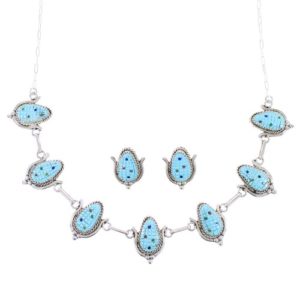
The Zuni have become masters in working with both turquoise and silver. Their expertise was crafted centuries ago and began with simple jewelry crafting. The art evolved as the culture adapted to newer techniques until eventually, they learned the skill to smith, learning to work with metals and crafting new types of jewelry with that skill.
It was the Navajo that initially learned how to work with silver from the Spanish, but the skill quickly enveloped most of the Southwestern tribes in the early 19th century, leading to a shift in the way the Southwest decorated their homes.
This spirit still persists today in the modern aesthetic of Southwestern homes, decoration, jewelry, and fashion.
One of the most prevalent styles in this region of the United States is the use of Zuni turquoise necklaces. These stunning works of Native American art are the epitome of Southwestern style and have been worn by musicians and actors alike.
What really makes these pieces so original is the fact that authentic Zuni turquoise necklaces are made with the same skills, techniques, and traditions as they were over a hundred years ago. The tools and styles have changed, but the heart and core of the pieces have not.
Zuni necklaces will usually feature turquoise and, on occasion, other stones like red coral. The proportions of Zuni turquoise necklaces are smaller than Navajo. They will be well-balanced so the stone does not overpower the silver.
Zuni jewelry will also feature Native American symbolism, like animals. Pieces that have an animal symbol are believed to give the wearer those traits as well. Zuni art can also use multiple stones to create an image on the piece as well.
Zuni artisans are talented at their craft because it combines a way of life with cultural values. Zuni turquoise necklaces give the artist a chance to reflect their heritage in their work.
